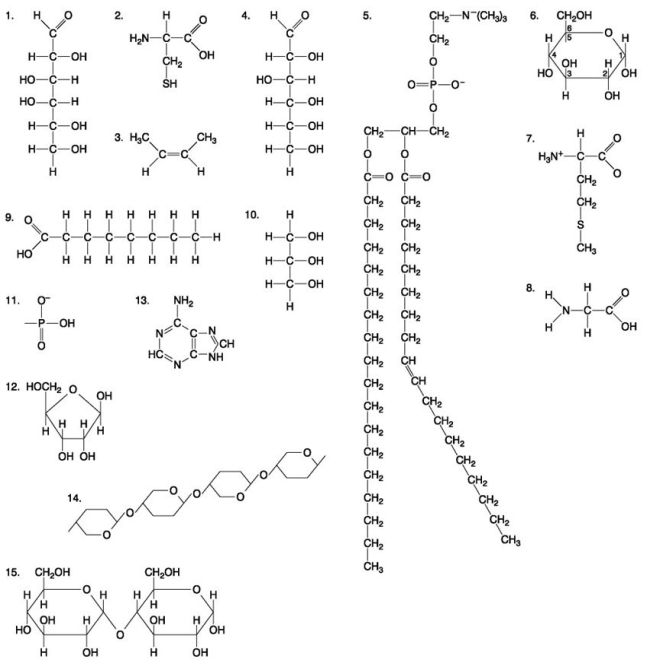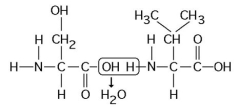A) 120 adenine and 120 uracil molecules.
B) 120 thymine and 120 adenine molecules.
C) 120 cytosine and 120 thymine molecules.
D) 120 adenine and 120 cytosine molecules.
E) 120 guanine and 120 thymine molecules.
G) A) and D)
Correct Answer

verified
Correct Answer
verified
Multiple Choice
The amino acids of the protein keratin are arranged predominantly in an α helix. This secondary structure is stabilized by
A) covalent bonds.
B) peptide bonds.
C) ionic bonds.
D) polar bonds.
E) hydrogen bonds.
G) A) and B)
Correct Answer

verified
Correct Answer
verified
Multiple Choice
Use the following information to answer the questions below. You have just had a breakfast of toast (high-fibre bread) with butter and jam (no added sugar) along with a glass of milk. -The structural level of a protein least affected by a disruption in hydrogen bonding is the
A) primary level.
B) secondary level.
C) tertiary level.
D) quaternary level.
E) All structural levels are equally affected.
G) All of the above
Correct Answer

verified
Correct Answer
verified
Multiple Choice
A molecule with the formula C₁₈H₃₆O₂ is probably a
A) carbohydrate.
B) fatty acid.
C) protein.
D) nucleic acid.
E) hydrocarbon.
G) B) and E)
Correct Answer

verified
Correct Answer
verified
Multiple Choice
The following questions are based on the 15 molecules illustrated in the figure below. Each molecule may be used once, more than once, or not at all.
 -Which of the following molecules has a functional group that frequently forms covalent bonds that maintain the tertiary structure of a protein?
-Which of the following molecules has a functional group that frequently forms covalent bonds that maintain the tertiary structure of a protein?
A) 2
B) 3
C) 7
D) 8
E) 9
G) A) and B)
Correct Answer

verified
Correct Answer
verified
Multiple Choice
The tertiary structure of a protein is the
A) bonding together of several polypeptide chains by weak bonds.
B) order in which amino acids are joined in a polypeptide chain.
C) unique three-dimensional shape of the fully folded polypeptide.
D) organization of a polypeptide chain into an α helix or β pleated sheet.
E) overall protein structure resulting from the aggregation of two or more polypeptide subunits.
G) C) and D)
Correct Answer

verified
Correct Answer
verified
Multiple Choice
Which class of biological molecules are grouped together because they are hydrophobic?
A) carbohydrates
B) lipids
C) proteins
D) nucleic acids
E) This is not a criterion for grouping molecules.
G) All of the above
Correct Answer

verified
Correct Answer
verified
Multiple Choice
The following questions are based on the 15 molecules illustrated in the figure below. Each molecule may be used once, more than once, or not at all.
 -Which of the following molecules contains a glycosidic linkage type of covalent bond?
-Which of the following molecules contains a glycosidic linkage type of covalent bond?
A) 4
B) 6
C) 12
D) 13
E) 15
G) D) and E)
Correct Answer

verified
Correct Answer
verified
Multiple Choice
Which of the following statements concerning saturated fats is not true?
A) They are more common in animals than in plants.
B) They have multiple double bonds in the carbon chains of their fatty acids.
C) They generally solidify at room temperature.
D) They contain more hydrogen than unsaturated fats having the same number of carbon atoms.
E) They are one of several factors that contribute to atherosclerosis.
G) A) and E)
Correct Answer

verified
Correct Answer
verified
Multiple Choice
How will brief heating (to 95°C) affect macromolecular structures in aqueous solution?
A) DNA duplexes will unwind and separate.
B) Proteins will unfold (denature) .
C) Starch will hydrolyze into monomeric sugars.
D) Proteins will hydrolyze into amino acids.
E) DNA duplexes will unwind and separate, and proteins will unfold (denature) .
G) A) and E)
Correct Answer

verified
Correct Answer
verified
Multiple Choice
 -Which of the following statements is/are true regarding the chemical reaction illustrated in the figure above?
-Which of the following statements is/are true regarding the chemical reaction illustrated in the figure above?
A) It is a hydrolysis reaction.
B) It results in a peptide bond.
C) It joins two fatty acids together.
D) It is a hydrolysis reaction and it results in a peptide bond.
E) It is a hydrolysis reaction, it results in a peptide bond, and it joins two fatty acids together.
G) A) and E)
Correct Answer

verified
Correct Answer
verified
Multiple Choice
Which of the following is not a monomer/polymer pairing?
A) monosaccharide/polysaccharide
B) amino acid/protein
C) triglyceride/phospholipid bilayer
D) deoxyribonucleotide/DNA
E) ribonucleotide/RNA
G) A) and C)
Correct Answer

verified
Correct Answer
verified
Multiple Choice
DNAase is an enzyme that catalyzes the hydrolysis of the covalent bonds that join nucleotides together. What would first happen to DNA molecules treated with DNAase?
A) The two strands of the double helix would separate.
B) The phosphodiester bonds between deoxyribose sugars would be broken.
C) The purines would be separated from the deoxyribose sugars.
D) The pyrimidines would be separated from the deoxyribose sugars.
E) All bases would be separated from the deoxyribose sugars.
G) A) and C)
Correct Answer

verified
Correct Answer
verified
Multiple Choice
The following questions are based on the 15 molecules illustrated in the figure below. Each molecule may be used once, more than once, or not at all.
 -Which molecule is a saturated fatty acid?
-Which molecule is a saturated fatty acid?
A) 1
B) 5
C) 6
D) 8
E) 9
G) A) and E)
Correct Answer

verified
Correct Answer
verified
Multiple Choice
What aspects of protein structure are stabilized or assisted by hydrogen bonds?
A) primary structure
B) secondary structure
C) tertiary structure
D) quaternary structure
E) secondary, tertiary, and quaternary structures, but not primary structure
G) A) and D)
Correct Answer

verified
Correct Answer
verified
Multiple Choice
The covalent bond formed between two monosaccharides by way of dehydration is called a(n)
A) hydrogen bond.
B) sulphide bridge.
C) glycosidic link.
D) glucose bridge.
E) disaccharide link.
G) B) and E)
Correct Answer

verified
Correct Answer
verified
Multiple Choice
Use the following information to answer the questions below. You have just had a breakfast of toast (high-fibre bread) with butter and jam (no added sugar) along with a glass of milk. -Which of the following pairs of base sequences could form a short stretch of a normal double helix of DNA?
A) 5'-purine-pyrimidine-purine-pyrimidine-3' with 3'-purine-pyrimidine-purine-pyrimidine-5'
B) 5'-AGCT-3' with 5'-TCGA-3'
C) 5'-GCGC-3' with 5'-TATA-3'
D) 5'-ATGC-3' with 5'-GCAT-3'
E) All of these pairs are correct.
G) A) and E)
Correct Answer

verified
Correct Answer
verified
Multiple Choice
Polysaccharides, triacylglycerides, and proteins are similar in that they
A) are synthesized from monomers by the process of hydrolysis.
B) are synthesized from subunits by dehydration reactions.
C) are synthesized as a result of peptide bond formation between monomers.
D) are decomposed into their subunits by dehydration reactions.
E) all contain nitrogen in their monomer building blocks.
G) B) and C)
Correct Answer

verified
Correct Answer
verified
Multiple Choice
Which of the four classes of biological molecules is not a polymer and thus isn't formed by dehydration?
A) carbohydrates
B) lipids
C) proteins
D) nucleic acids
E) All can be considered polymers.
G) C) and D)
Correct Answer

verified
Correct Answer
verified
Multiple Choice
The following questions are based on the 15 molecules illustrated in the figure below. Each molecule may be used once, more than once, or not at all.
 -Which of the following molecules is an amino acid with a hydrophobic R group or side chain?
-Which of the following molecules is an amino acid with a hydrophobic R group or side chain?
A) 3
B) 7
C) 8
D) 12
E) 13
G) C) and E)
Correct Answer

verified
Correct Answer
verified
Showing 41 - 60 of 117
Related Exams